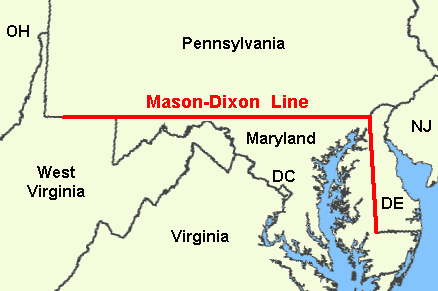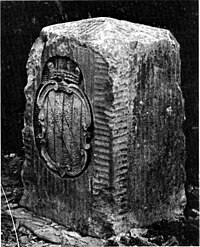History of the Mason-Dixon Line
 The Mason-Dixon Line (or "Mason and Dixon's Line") was surveyed between 1763 and 1767 by
Charles Mason and
Jeremiah Dixon
in the resolution of a border dispute between
British colonies
in
Colonial America
. It forms a
demarcation line
between four
U.S. states
, forming part of the borders of
Pennsylvania
,
Maryland
,
Delaware
, and
West Virginia
(then part of
Virginia
). In popular usage, especially since the
Missouri compromise
of 1820 (apparently the first official usage of the term "Mason's and Dixon's Line"), the Mason-Dixon Line symbolizes a cultural boundary between the
Northern United States
and the
Southern United States
The Mason-Dixon Line (or "Mason and Dixon's Line") was surveyed between 1763 and 1767 by
Charles Mason and
Jeremiah Dixon
in the resolution of a border dispute between
British colonies
in
Colonial America
. It forms a
demarcation line
between four
U.S. states
, forming part of the borders of
Pennsylvania
,
Maryland
,
Delaware
, and
West Virginia
(then part of
Virginia
). In popular usage, especially since the
Missouri compromise
of 1820 (apparently the first official usage of the term "Mason's and Dixon's Line"), the Mason-Dixon Line symbolizes a cultural boundary between the
Northern United States
and the
Southern United StatesMaryland and Pennsylvania both claimed the land between the 39th and 40th parallels according to the charters granted to each colony. The 'Three Lower Counties' (Delaware) along Delaware Bay moved into the Penn sphere of settlement, and later became the Delaware Colony, a satellite of Pennsylvania.
In 1732 the proprietary governor of Maryland, Charles Calvert, 5th Baron Baltimore, signed an agreement with William Penn's sons which drew a line somewhere in between, and also renounced the Calvert claim to Delaware. But later Lord Baltimore claimed that the document he signed did not contain the terms he had agreed to, and refused to put the agreement into effect. Beginning in the mid-1730s, violence erupted between settlers claiming various loyalties to Maryland and Pennsylvania. The border conflict between Pennsylvania and Maryland would be known as Cresap's War.
The issue was unresolved until the Crown intervened in 1760, ordering Frederick Calvert, 6th Baron Baltimore to accept the 1732 agreement. As part of the settlement, the Penns and Calverts commissioned the English team of Charles Mason and Jeremiah Dixon to survey the newly established boundaries between the Province of Pennsylvania, the Province of Maryland, Delaware Colony and parts of Colony and Old Dominion of Virginia.
After Pennsylvania abolished slavery in 1781, the western part of this line and the Ohio River became a border between free and slave states, although Delaware remained a slave state.
Geography
Mason and Dixon's actual survey line began to the south of Philadelphia, Pennsylvania, and extended from a benchmark east to the Delaware River and west to what was then the boundary with western Virginia.
The surveyors also fixed the boundary between Delaware and Pennsylvania and the approximately north-south portion of the boundary between Delaware and Maryland. Most of the Delaware-Pennsylvania boundary is a circular arc, and the Delaware-Maryland boundary does not run truly north-south because it was intended to bisect the Delmarva Peninsula rather than follow a meridian.
The Maryland-Pennsylvania boundary is an east-west line with an approximate mean latitude of 39° 43' 20" N ( Datum WGS 84). In reality, the east-west Mason-Dixon line is not a true line in the geometric sense, but is instead a series of many adjoining lines, following a path between latitude 39° 43' 15" N and 39° 43' 23" N; a surveyor or mapper might call it an approximate rhumb line. As such, the line approximates a segment of a small circle upon the surface of the (also approximately) spherical Earth. An observer standing on such a line and viewing its path toward an unobstructed horizon would perceive it to bend away from his line of sight, an effect of the inequality between the amount of curvature to his left and right. Among parallels of latitude, only the Equator is a great circle and would not exhibit this effect.
The Mason-Dixon Line was marked by stones every mile and "crownstones" every five miles, using stone shipped from England. The Maryland side says (M) and the Delaware and Pennsylvania sides say (P). Crownstones include the two coats-of-arms. Today, while a number of the original stones are missing or buried, many are still visible, resting on public land and protected by iron cages.
Mason and Dixon confirmed earlier survey work which delineated Delaware's southern boundary from the Atlantic Ocean to the "Middle Point" stone (along what is today known as the Transpeninsular Line). They proceeded nearly due north from this to the Pennsylvania border.
Later the line was marked in places by additional benchmarks and survey markers. The lines have been resurveyed several times over the centuries without substantive changes to Mason and Dixon's work. The stones may be a few to a few hundred feet east or west of the point Mason and Dixon thought they were; in any event, the line drawn from stone to stone forms the legal boundary.
According to Dave Doyle at the National Geodetic Survey, part of the National Oceanic and Atmospheric Administration, the common corner of Pennsylvania, Maryland, and Delaware, at The Wedge is marked by Boundary Monument #87. The marker "MDP Corner" dates from 1935 and is offset on purpose.
Doyle said the Maryland-Pennsylvania Mason-Dixon Line is exactly:
- 39° 43%u2032 19.92216%u2033 N
and Boundary Monument #87 is on that parallel, at:
- 075° 47%u2032 18.93851%u2033 W.
Visitors to the tripoint are strongly encouraged to first obtain permission from the nearest landowner, or use the path from the arc corner monument which is bordered by Delaware parkland most of the way, and Pennslyvania parkland the entire way.
History
The line was established to end a boundary dispute between the British colonies of Maryland and Pennsylvania/Delaware. Due to incorrect maps and confusing legal descriptions, the royal charters of the three colonies overlapped. Maryland was granted the territory north of the Potomac River/ Watkins Pointup to the fortieth parallel; Pennsylvania was granted land extending northward from a point "12 miles north of New Castle Towne," which is located south of the fortieth parallel. The most serious problem was that the Maryland claim would put Philadelphia, which became the major city in Pennsylvania, within Maryland. A protracted legal dispute between the Calvert family, which controlled Maryland, and the Penn family, which controlled Pennsylvania and the "Three Lower Counties" (Delaware), was ended by the 1750 ruling that the boundary should be fixed as follows:
- Between Pennsylvania and Maryland:
- The parallel (latitude line) fifteen miles (24 km) south of the southernmost point in Philadelphia, measured to be at about 39° 43' N and agreed upon as the Maryland-Pennsylvania line.
-
Between Delaware and Maryland:
- The existing east-west Transpeninsular Line from the Atlantic Ocean to its mid-point to the Chesapeake Bay.
- A Twelve Mile (radius) Circle around the city of New Castle, Delaware.
- A "Tangent Line" connecting the mid-point of the Transpeninsular Line to the western side of the Twelve-Mile Circle.
- A "North Line" along the meridian (line of longitude) from the tangent point to the Maryland Pennsylvania border.
- Should any land within the Twelve-Mile Circle fall west of the North Line, it would remain part of Delaware. (This was indeed the case, and this border is the "Arc Line.")
The disputants engaged an expert British team, astronomer Charles Mason and surveyor Jeremiah Dixon, to survey what became known as the Mason-Dixon Line. It cost the Calverts of Maryland and the Penns of Pennsylvania £3,512/9 s to have 244 miles surveyed with such accuracy. To them the money was well spent, for in a new country there was no other way of establishing ownership.
The Mason-Dixon line is made up of four segments corresponding to the terms of the settlement: Tangent Line, North Line, Arc Line, and 39° 43' N parallel. The most difficult task was fixing the Tangent Line, as they had to confirm the accuracy of the Transpeninsular Line mid-point and the Twelve-Mile Circle, determine the tangent point along the circle, then actually survey and monument the border. They then surveyed the North and Arc Lines. They did this work between 1763 and 1767. This actually left a small wedge of land in dispute between Delaware and Pennsylvania until 1921.
In April 1765, Mason and Dixon began their survey of the more famous Maryland-Pennsylvania line. They were commissioned to run it for a distance of five degrees of longitude west from the Delaware River, fixing the western boundary of Pennsylvania (see the entry for Yohogania County). However, in October 1767 at Dunkard Creek near Mount Morris, Pennsylvania, nearly 244 miles (392 km) west of the Delaware, a group of Native Americans forced them to quit their progress. In 1784, surveyors David Rittenhouse and Andrew Ellicott and their crew completed the survey of the Mason-Dixon line to the southwest corner of Pennsylvania, five degrees from the Delaware River. Other surveyors continued west to the Ohio River. The section of the line between the southwestern corner of Pennsylvania and the river is the county line between Marshall and Wetzel counties, West Virginia.
The boundary between Pennsylvania and Maryland was resurveyed in 1849, then again in 1900.
The Missouri Compromise of 1820 created the political conditions which made the Mason-Dixon Line important to the history of slavery. It was during the Congressional debates leading up to the compromise that the term "Mason-Dixon line" was first used to designate the entire boundary between free states and slave states.
On November 14, 1963, during the bicentennial of the Mason-Dixon Line, U.S. President John F. Kennedy opened a newly completed section of Interstate 95 where it crossed the Maryland-Delaware border. It was his last public appearance before the one 8 days later in Dallas, Texas, where he was assassinated. The Delaware Turnpike and the Maryland portion of the new road were each later designated as the John F. Kennedy Memorial Highway.
Recent News
- March 12 2024 Town Meeting Agenda
- February 27, 2024 Town Meeting Agenda
- COVID -19 TOWN SERVICES ACTION PLAN #4Provides an update to a confirm Covid-19 case in Town limits, closing of Town Parks & recommended safe practi...
- COVID -19 TOWN SERVICES ACTION PLAN #3Closing of Town Park Equipment for public use
- COVID 19 - TOWN SERVICES ACTION PLAN - #2Summarizes Governor Hogan's executive orders and additional steps being taken by the Town of Rising Sun
Upcoming Events
- MAYOR & COMMISSIONERS - TOWN MEETING12/10/245:30 pm - 11:59 pm
- MAYOR & COMMISSIONERS - TOWN MEETING12/10/245:30 pm - 11:59 pm
- MAYOR & COMMISSIONERS - TOWN MEETING01/14/255:30 pm - 11:59 pm
- MAYOR & COMMISSIONERS - TOWN MEETING01/14/255:30 pm - 11:59 pm
- TOWN HOLIDAY - MARTIN LUTHER KING DAY01/20/25 All Day
In this Department
 Department Home
Department Home


